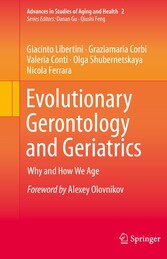
Evolutionary Gerontology and Geriatrics - Why and How We Age
von: Giacinto Libertini, Graziamaria Corbi, Valeria Conti, Olga Shubernetskaya, Nicola Ferrara
Springer-Verlag, 2021
ISBN: 9783030737740
Sprache: Englisch
426 Seiten, Download: 14820 KB
Format: PDF, auch als Online-Lesen
| Foreword | 7 | ||
| Terminology + Abbreviations | 9 | ||
| Contents | 12 | ||
| Chapter 1: Introduction | 17 | ||
| 1.1 Evolutionary Medicine and ``Evolutionary Gerontology and Geriatrics´´ | 17 | ||
| 1.2 Definition of Aging | 18 | ||
| 1.3 Aging in Natural Observation | 20 | ||
| 1.4 A Short History of Aging Theories | 24 | ||
| 1.4.1 The Conception of Aging Up to Nineteenth Century | 24 | ||
| 1.4.2 Aging Theories in the Nineteenth Century and the First Half of the Twentieth Century | 26 | ||
| 1.4.3 Aging Theories from the Second Half of the Twentieth Century to Today | 32 | ||
| 1.4.4 Classification of Aging Theories | 40 | ||
| References | 41 | ||
| Chapter 2: Evolution and Phenoptosis | 48 | ||
| 2.1 Darwinian Definition of Natural Selection | 48 | ||
| 2.2 Supra-Individual Selection | 49 | ||
| 2.3 Definition of Phenoptosis | 52 | ||
| 2.4 Examples of Phenoptosis and Its Wide Diffusion | 53 | ||
| 2.4.1 (A) Obligatory and Rapid Phenoptosis | 53 | ||
| 2.4.2 (B) Obligatory and Slow Phenoptosis | 56 | ||
| 2.4.3 (C) Optional Phenoptosis | 58 | ||
| 2.4.4 (D) Indirect Phenoptosis | 63 | ||
| 2.5 Phenoptotic Phenomena in our Species | 65 | ||
| 2.6 Life Tables and Phenoptosis | 66 | ||
| References | 77 | ||
| Chapter 3: Evolutionary Medicine | 84 | ||
| 3.1 Definition of Evolutionary Medicine | 84 | ||
| 3.2 A Brief History of Evolutionary Medicine | 84 | ||
| 3.3 The Concept of Normality in Evolutionary Medicine | 94 | ||
| 3.4 The Concept of Mismatch in Evolutionary Medicine | 99 | ||
| 3.5 Diseases Caused by Mismatches | 99 | ||
| 3.6 Diseases Caused by Alterations of the Genotype | 100 | ||
| 3.7 The Concept of Holobiont | 106 | ||
| 3.8 Immune Disorders in the Interpretation of Evolutionary Medicine | 107 | ||
| 3.8.1 The Current ``Epidemic´´ of Allergic Diseases | 107 | ||
| 3.8.2 The Current ``Epidemic´´ of Autoimmune Diseases | 108 | ||
| 3.8.3 Causes of the Epidemic of Immune Disorders | 112 | ||
| 3.9 Non-evolutionary Classification of Diseases | 121 | ||
| 3.10 Evolutionary Classification of Diseases | 122 | ||
| 3.11 Meaning and Aims of Evolutionary Medicine | 126 | ||
| References | 129 | ||
| Chapter 4: The Comparison Between the Two Paradigms | 136 | ||
| 4.1 Introduction | 136 | ||
| 4.2 The Paradigm of Aging as a Non-adaptive Phenomenon | 137 | ||
| 4.3 The Paradigm of Aging as an Adaptive Phenomenon | 140 | ||
| 4.4 Arguments and Evidence in Support or Against the Theories Pertaining to the Two Paradigms | 144 | ||
| 4.4.1 Absence of Unlikely Postulates | 144 | ||
| 4.4.2 Non-universality of Aging | 146 | ||
| 4.4.3 Variation of Aging Rhythms in the Comparison among Species | 147 | ||
| 4.4.4 Consideration of Supra-Individual Natural Selection and Phenoptotic Phenomena | 150 | ||
| 4.4.5 Effects of Caloric Restriction on Lifespan | 150 | ||
| 4.4.6 Existence of Age-Related Increasing Mortality in the Wild | 151 | ||
| 4.4.7 In the Comparison Among Species, the Inverse Relation Between Extrinsic Mortality and the Proportion of Deaths Due to In... | 154 | ||
| 4.4.8 Impossibility of Explaining Age-Related Fitness Decline as a Consequence of Genes that Are Harmful at a Certain Age | 157 | ||
| 4.4.9 Age-Related Progressive Decline of Cell Turnover Capacities | 160 | ||
| 4.4.10 Cell Senescence Program | 162 | ||
| 4.4.11 Gradual Cell Senescence | 163 | ||
| 4.4.12 General Evaluation of the Arguments Mentioned earlier | 164 | ||
| 4.5 Aging as an Accelerating Factor of Evolution Theory | 166 | ||
| 4.6 Kin Selection Aging Theory | 168 | ||
| 4.6.1 Definitions | 169 | ||
| 4.6.2 The Evolutionary Advantage of a Shorter ML | 170 | ||
| 4.6.3 Effects of IMICAW on ML | 172 | ||
| 4.6.4 Evolutionary Steadiness of a Gene Causing IMICAW | 173 | ||
| 4.6.5 The Preliminary Conditions | 178 | ||
| 4.6.6 Two Possible Objections | 179 | ||
| 4.6.7 The Methuselah Effect | 179 | ||
| 4.6.8 IMICAW, IMICAC, and t-genes | 183 | ||
| References | 184 | ||
| Chapter 5: Subtelomere-Telomere Aging Theory | 194 | ||
| 5.1 Description of the Subtelomere-Telomere Theory | 194 | ||
| 5.1.1 Limits in Cell Duplication Capacities | 195 | ||
| 5.1.2 Probabilistic Relation Between Telomere Shortening and Replicative Senescence | 199 | ||
| 5.1.3 Suggestions from the Yeast | 200 | ||
| 5.1.4 Gradual Cell Senescence and Cell Senescence | 204 | ||
| 5.1.5 Absence of Relation Between Longevity and Telomere Initial Length | 209 | ||
| 5.2 Metabolic Changes in Aging Cells | 214 | ||
| 5.3 Atrophic Syndrome | 215 | ||
| 5.4 Limits in Cell Duplication Capacities and Other Effects of the Telomere-Subtelomere-Telomerase System Explained as a Gener... | 216 | ||
| 5.5 The Telomere | 222 | ||
| 5.6 The Telomerase Enzyme | 225 | ||
| 5.7 The Subtelomere | 227 | ||
| 5.8 The Heterochromatin Hood Over the Telomere | 232 | ||
| References | 240 | ||
| Chapter 6: Aging in the Human Species | 255 | ||
| 6.1 Alterations Consequent to the Actions of the Telomere-Subtelomere-Telomerase System | 255 | ||
| 6.1.1 Alterations of Cellular Metabolism | 255 | ||
| 6.1.2 Alterations of Cell Turnover | 257 | ||
| 6.2 Direct Aging | 272 | ||
| 6.2.1 Endothelium | 272 | ||
| 6.2.2 Skin | 275 | ||
| 6.2.3 Olfactory Receptor Cells | 276 | ||
| 6.2.4 Other Peripheral Sensory Neuronal Cells (Excluding Olfactory Receptor Cells) | 276 | ||
| 6.2.5 Skeletal Muscle | 277 | ||
| 6.2.6 Heart | 277 | ||
| 6.2.7 Gastrointestinal System | 279 | ||
| 6.2.8 Orofacial Tissues and Organs | 280 | ||
| 6.2.9 Lungs | 281 | ||
| 6.2.10 Kidneys | 281 | ||
| 6.2.11 Pancreatic ?-cells | 282 | ||
| 6.2.12 Bone and Joints | 282 | ||
| 6.2.13 Liver | 284 | ||
| 6.2.14 Hematopoietic Cells and Bone Marrow | 285 | ||
| 6.2.15 Testes | 285 | ||
| 6.3 Indirect Aging | 285 | ||
| 6.3.1 Photoreceptor Cells | 286 | ||
| 6.3.2 Neurons of the Central Nervous System | 286 | ||
| 6.3.3 Auditory Neurons | 286 | ||
| 6.3.4 Crystalline Lens | 287 | ||
| 6.4 General Schemes | 287 | ||
| References | 290 | ||
| Chapter 7: The Elderly Subjects and Their Troubles | 305 | ||
| 7.1 Evolutionary Classification of the Troubles of the Elderly | 305 | ||
| 7.2 Age-Related Fitness Decline | 308 | ||
| 7.3 Diseases Due to Genetic Alterations | 311 | ||
| 7.4 Diseases Due to Genetic Alterations That Cause Aging-Like Syndromes | 313 | ||
| 7.5 Diseases Deriving from `Extremes´ of the Ecological Niche and Relations with Other Living Beings | 320 | ||
| 7.6 Diseases Caused by Mismatches | 323 | ||
| 7.7 Diseases Caused by Mismatches That Speed Up Physiological Aging | 327 | ||
| 7.8 Weight of Physiological Aging | 336 | ||
| References | 340 | ||
| Chapter 8: Prevention and Treatment of the Troubles of the Elderly | 364 | ||
| 8.1 Rationality of the Evolutionary Approach | 364 | ||
| 8.2 Prevention and Treatment of Diseases Identical or Similar at Any Age | 365 | ||
| 8.3 Acceleration of Aging: Prevention and Treatment | 366 | ||
| 8.4 Treatment of Physiological Aging | 370 | ||
| 8.4.1 Telomerase Activation | 371 | ||
| 8.4.2 Elimination of Senescent Cells | 374 | ||
| 8.4.3 Anti-aging Substances and Methods | 379 | ||
| 8.4.4 Genetic Modifications | 386 | ||
| 8.4.5 Ethical Problems | 390 | ||
| 8.5 Current Geriatrics and Society | 392 | ||
| 8.6 Future Geriatrics and Society | 393 | ||
| References | 396 | ||
| Appendices | 414 | ||
| Appendix: Part A | 414 | ||
| Haploid Condition | 414 | ||
| Diploid Condition | 420 | ||
| Case Alpha (Different Effects in Heterozygous and Homozygous Conditions) | 421 | ||
| Case Beta (Recessive Gene) | 421 | ||
| Case Gamma (Dominant Gene) | 421 | ||
| Case Alpha (Different Effects in Heterozygous and Homozygous Conditions) | 422 | ||
| Case Beta (Recessive Gene) | 423 | ||
| Case Gamma (Dominant Gene) | 423 | ||
| Case Alpha (Different Effects in Heterozygous and Homozygous Conditions) | 423 | ||
| Case Beta (Recessive Gene) | 423 | ||
| Case Gamma (Dominant Gene) | 424 | ||
| Appendix: Part B | 425 | ||
| Reference | 426 |








